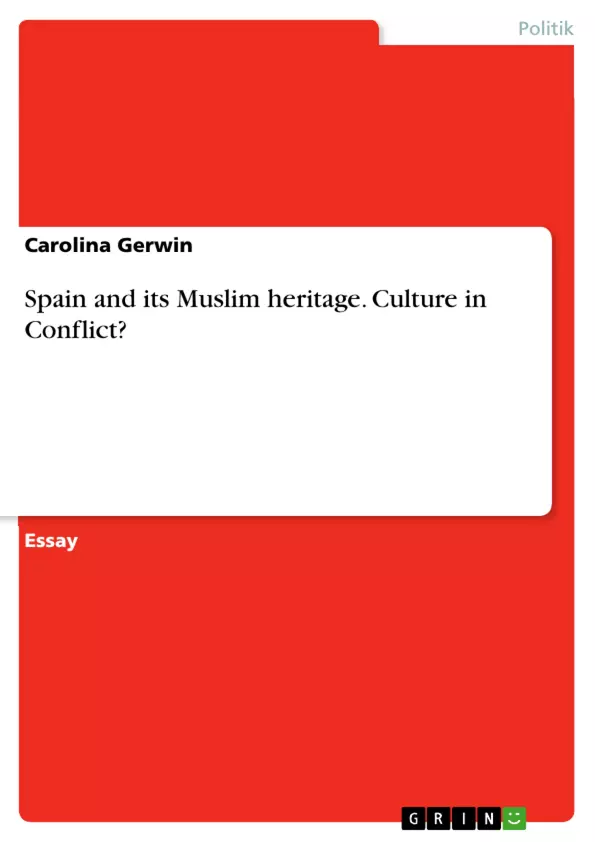The paper deals with the question of how the orientalist painting “The surrender of Granada” by Francisco Pradilla y Ortiz represents the capitulation of Granada in 1492. The essay argues that the painting is an example of the 19th century Orientalism in Spain as it stresses the dichotomy between Christianity and Islam by emphasizing the weakness of the Muslim “other” while highlighting the triumph of the Christian Monarchs. Firstly, the reasons for Spain’s conflict regarding its Muslim heritage is given. After that, Pradilla’s painting is analysed and put into the context of 19th century Orientalism. Finally, the contemporary situation in Spain is examined.
The year 1492 plays an important role in the country of Spain and especially the region of Al-Andalus. On the 2nd of January 1492, the last Islamic kingdom in Spain, the Nasrid dynasty, surrendered to King Ferdinand of Aragon and Queen Isabella of Castille, also called the Catholic Monarchs, in the Alhambra of Granada. Over the next ten years, Muslims who had stayed in Spain were forced to convert to Christianity, were relocated and finally, in the early 17th century, banished from Spain. This point already shows that the conflict between Muslims and Christians in Spain did not stop in 1492 but continued to remain. According to McSweeney and Hopkins, even nowadays, the events that happened over 500 years ago, still evoke problems as there is a discussion going on in Spain on how to incorporate its Muslim heritage with Spain’s identity nowadays as a European and mostly Christian country.
Inhaltsverzeichnis
- Culture in Conflict: Spain and its Muslim heritage
- The Alhambra: A Building that Reflects the Transition from Muslim to Christian Rule in Al-Andalus
- The Alhambra: A Building that Reflects the Transition from Muslim to Christian Rule in Al-Andalus
- A Building of Contrasts: The Alhambra as a Monument to the Spanish Muslim Heritage and its Impact on Spain's Identity
- The Alhambra and the Orientalist Discourse of 19th-Century Spain
- The Alhambra: An Example of Spain's Muslim and Christian Heritage and its Contemporary Impact on Spain's Identity
Zielsetzung und Themenschwerpunkte
Der Text untersucht die historische und aktuelle Bedeutung der Alhambra in Granada, Spanien. Er analysiert, wie die Alhambra als Beispiel für die kulturelle Verschmelzung von muslimischer und christlicher Geschichte in Spanien dient und wie sie die nationale Identität des Landes beeinflusst hat.
- Die Alhambra als Symbol des Übergangs von der muslimischen zur christlichen Herrschaft in Al-Andalus.
- Die Alhambra als Beispiel für die Verschmelzung muslimischer und christlicher Architektur und Kultur in Spanien.
- Der Einfluss des Orientalismus auf die Darstellung der Alhambra im 19. Jahrhundert.
- Die aktuelle Bedeutung der Alhambra als Kulturerbe und Symbol des muslimischen Erbes Spaniens.
- Die Rolle der Alhambra in der aktuellen Debatte über die nationale Identität Spaniens.
Zusammenfassung der Kapitel
- Der Text beginnt mit einer Einführung in die Geschichte der Alhambra und ihren Platz im Kontext der Geschichte Al-Andalusiens.
- Er analysiert die Alhambra als Bauwerk, das die Verschmelzung muslimischer und christlicher Architektur und Kultur in Spanien widerspiegelt.
- Der Text beleuchtet die Rolle des Orientalismus in der Darstellung der Alhambra im 19. Jahrhundert und zeigt, wie dieses Konzept dazu beitrug, das muslimische Erbe Spaniens zu untergraben.
- Es werden Beispiele dafür angeführt, wie die Alhambra im 21. Jahrhundert weiterhin als kulturelles Erbe und Symbol des muslimischen Erbes Spaniens wahrgenommen wird.
Schlüsselwörter
Die wichtigsten Schlüsselwörter und Themen des Textes sind die Alhambra, Al-Andalus, muslimisches Erbe Spaniens, Orientalismus, nationale Identität Spaniens, kulturelle Verschmelzung und die Verschmelzung von Geschichte und Architektur.
- Quote paper
- Carolina Gerwin (Author), 2017, Spain and its Muslim heritage. Culture in Conflict?, Munich, GRIN Verlag, https://www.grin.com/document/510900



